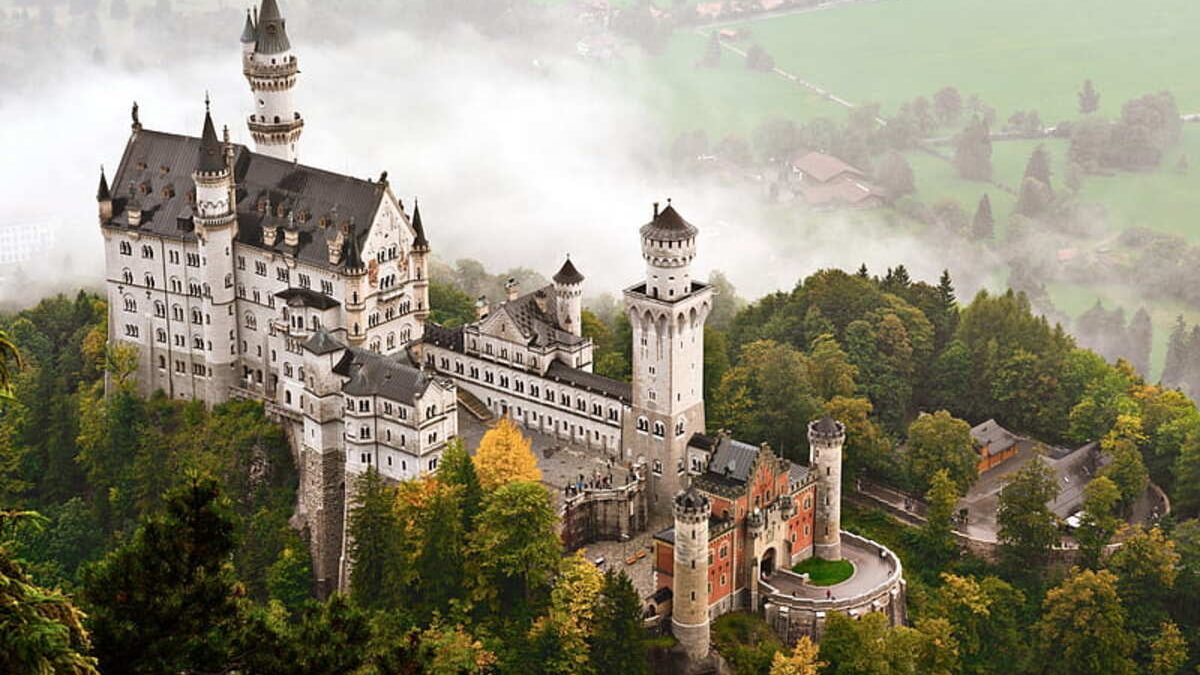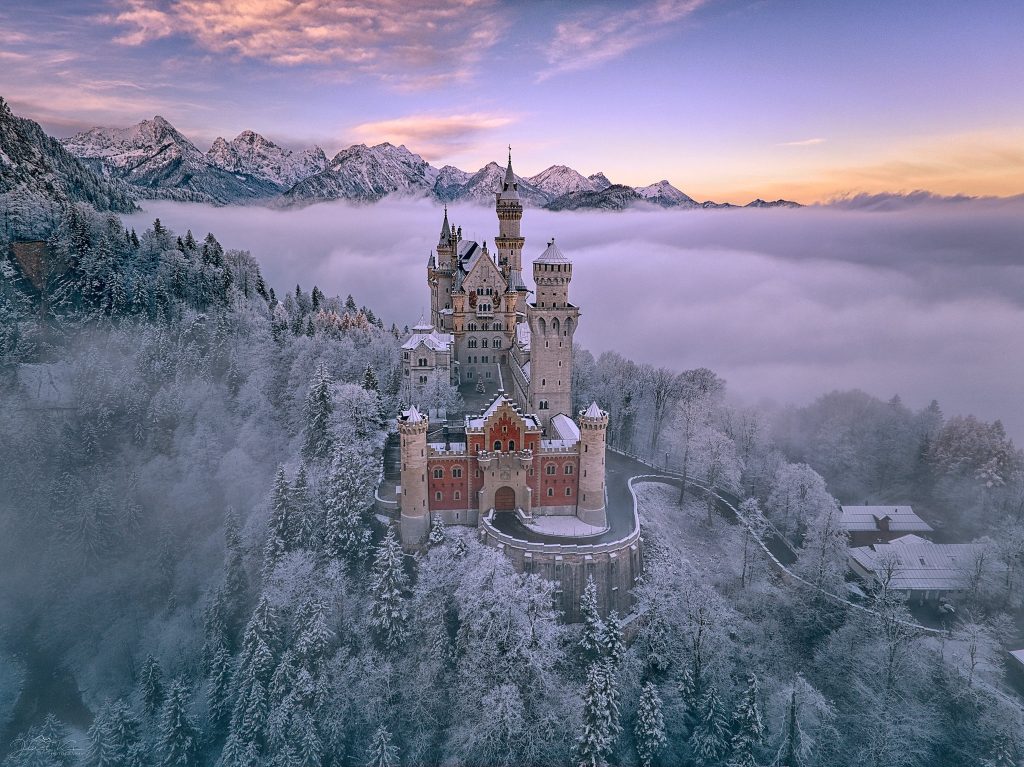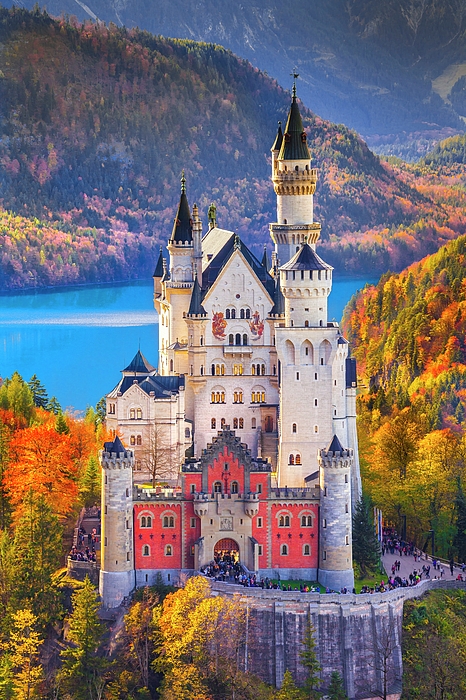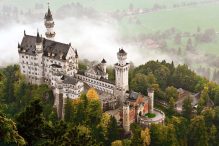Neuschwanstein Castle: The Fairy-Tale Fortress of Bavaria

Neuschwanstein Castle: The Fairy-Tale Fortress of Bavaria
Neuschwanstein Castle, perched high on a rugged hill above the village of Hohenschwangau in Bavaria, Germany, is one of the most famous and enchanting castles in the world. Known for its fairy-tale appearance and dramatic setting, Neuschwanstein attracts over 1.5 million visitors annually. This article delves into the history, architectural marvels, cultural significance, and tourist appeal of Neuschwanstein Castle, providing a comprehensive guide for anyone planning to visit this iconic landmark.

Historical Background of Neuschwanstein Castle
Commission and Construction: Neuschwanstein Castle was commissioned by King Ludwig II of Bavaria, also known as the “Mad King” or “Fairy-Tale King.” The construction began in 1869, and although it was never fully completed, the castle stands as a testament to Ludwig’s vision and eccentricity. The king wanted a retreat and a homage to the operas of Richard Wagner, whom he greatly admired. The castle’s design was influenced by the romantic ideals of the Middle Ages and the king’s own imagination.
Architects and Designers: The initial design was created by the stage designer Christian Jank, and it was later realized by architect Eduard Riedel. Georg von Dollmann, and later Julius Hofmann, also contributed to the castle’s development. The construction involved a blend of traditional craftsmanship and modern technology, including steel frameworks and electric lighting.
Ludwig II’s Vision: Ludwig II envisioned Neuschwanstein as a personal refuge away from the political pressures of Munich. He was deeply inspired by Wagnerian operas, medieval knights, and Gothic revival architecture. The king’s vision was to create an idealized version of a medieval castle, filled with towers, turrets, and battlements.

Architectural Marvels of Neuschwanstein Castle
Exterior Design: Neuschwanstein Castle’s exterior is characterized by its romantic and picturesque style, which has inspired countless stories, films, and even Disney’s Sleeping Beauty Castle. The castle is built from white limestone and features numerous towers and spires that contribute to its fairy-tale appearance. The location, atop a hill surrounded by the Bavarian Alps and overlooking the Hohenschwangau valley, adds to its dramatic and picturesque appeal.
Interior Design: The interior of Neuschwanstein Castle is equally impressive, though only about a third of the rooms were completed before Ludwig II’s death in 1886. The rooms that were finished reflect the king’s fascination with medieval legends and Wagnerian themes.
- Throne Hall: The Throne Hall is a grandiose room inspired by Byzantine architecture. It features a magnificent chandelier, intricate mosaics, and a grand staircase. The hall was intended to house Ludwig’s throne, which was never installed.
- Singer’s Hall: The Singer’s Hall occupies the entire fourth floor of the castle’s eastern wing. It is adorned with paintings depicting scenes from Wagner’s operas and medieval legends. The hall was designed for musical performances and is one of the largest rooms in the castle.
- King’s Bedroom: Ludwig’s bedroom is a masterpiece of Gothic revival architecture, featuring an elaborately carved wooden bed, frescoes of medieval knights, and a stunning view of the surrounding landscape. The room also includes a washstand with running water, a luxury at the time.
- Living Room: The living room, also known as the Grotto, is designed to resemble a cave, complete with stalactites and a waterfall. This room reflects Ludwig’s love for nature and fantasy.
- Chapel: The small but richly decorated chapel reflects Ludwig’s deep religious devotion. It features intricate woodwork, a painted ceiling, and a beautiful altar.
Cultural Significance of Neuschwanstein Castle
Ludwig II’s Legacy: King Ludwig II’s fascination with romanticism and medieval ideals is embodied in Neuschwanstein Castle. His eccentric personality and tragic end have added to the mystique of the castle. Ludwig was declared insane and deposed before he could complete his vision. His mysterious death, just days after his deposition, only deepened the intrigue surrounding his life and works.
Inspiration for Art and Media: Neuschwanstein Castle has served as an inspiration for various works of art, literature, and media. Its fairy-tale appearance has made it a favorite subject for artists and filmmakers. Walt Disney used Neuschwanstein as a model for the Sleeping Beauty Castle in Disneyland, further cementing its place in popular culture.
UNESCO World Heritage Site: Although Neuschwanstein itself is not a UNESCO World Heritage Site, it is part of the larger cultural landscape of the Bavarian Alps, which is recognized for its natural beauty and historical significance. The castle’s inclusion in this context highlights its importance as a cultural and historical landmark.

Tourist Appeal of Neuschwanstein Castle
Neuschwanstein Castle is one of the most popular tourist destinations in Germany. Its fairy-tale charm, historical significance, and breathtaking views attract visitors from around the world. Here are some key reasons why Neuschwanstein is a must-visit destination:
Scenic Beauty: The castle’s location in the Bavarian Alps provides stunning views of the surrounding landscape, including mountains, forests, and lakes. The approach to the castle, whether by foot, horse-drawn carriage, or shuttle bus, offers picturesque vistas that enhance the overall experience.
Architectural Wonder: The intricate design and craftsmanship of Neuschwanstein Castle make it a marvel of architecture. The blend of Gothic revival and Romanesque styles, combined with modern engineering techniques, creates a unique and captivating structure.
Historical Insight: Visitors to Neuschwanstein Castle gain a deeper understanding of King Ludwig II’s life, his artistic passions, and his troubled reign. The castle serves as a window into the romantic ideals and personal struggles of one of Bavaria’s most enigmatic monarchs.
Guided Tours: The castle offers guided tours that provide detailed information about its history, architecture, and the life of King Ludwig II. The tours take visitors through the completed rooms, offering insights into their design and significance.
Photographic Opportunities: Neuschwanstein Castle is a photographer’s paradise. Its striking silhouette, set against the backdrop of the Bavarian Alps, makes for stunning photographs. The best vantage points for capturing the castle’s beauty include Marienbrücke (Mary’s Bridge) and the surrounding hiking trails.
Nearby Attractions: The area around Neuschwanstein Castle offers additional attractions, including Hohenschwangau Castle, where Ludwig II spent much of his childhood, and the picturesque Alpsee lake. The nearby town of Füssen provides charming streets, historic sites, and additional amenities for visitors.
Practical Tips for Visiting Neuschwanstein Castle
To make the most of your visit to Neuschwanstein Castle, consider the following practical tips:
Plan Ahead: Neuschwanstein Castle is a popular tourist destination, so it’s essential to plan your visit in advance. Tickets can be purchased online, which is highly recommended to avoid long queues. The number of daily visitors is limited, so booking early ensures you get your preferred time slot.
Best Time to Visit: The castle is open year-round, but the best times to visit are during the spring and fall when the weather is pleasant, and the crowds are smaller. Summer is peak tourist season, while winter offers a quieter experience but with the possibility of snow enhancing the fairy-tale atmosphere.
Getting There: Neuschwanstein Castle is located near the town of Füssen. The most convenient way to reach the castle is by car or train to Füssen, followed by a short bus or taxi ride to Hohenschwangau. From there, visitors can choose to hike up to the castle, take a shuttle bus, or ride in a horse-drawn carriage.
Dress Appropriately: The walk up to the castle involves some uphill hiking, so wear comfortable shoes and dress appropriately for the weather. The interior of the castle can be cool, even in summer, so bringing a light jacket is advisable.
Photography: Photography is not allowed inside the castle, but visitors are encouraged to take pictures of the exterior and the surrounding landscape. The best spots for photos include Marienbrücke and the various hiking trails around the castle.
Guided Tours: All visitors must join a guided tour to see the interior of the castle. Tours are available in several languages and provide fascinating insights into the history and architecture of Neuschwanstein. Audio guides are also available for those who prefer a self-guided experience.
Accessibility: The castle is not fully accessible for visitors with mobility issues due to its hilltop location and numerous stairs. However, efforts have been made to accommodate visitors with disabilities, including a lift for wheelchairs and limited access to certain areas.

Unique Features and Charming Aspects of Neuschwanstein Castle
Neuschwanstein Castle’s charm lies in its blend of historical intrigue, architectural beauty, and fairy-tale allure. Several aspects make Neuschwanstein a unique and enchanting destination:
Ludwig II’s Vision: The castle is a physical manifestation of King Ludwig II’s dreams and fantasies. His passion for art, music, and medieval legends is evident in every detail, from the architectural design to the interior decorations.
Fairy-Tale Appearance: Neuschwanstein’s picturesque setting and whimsical design have made it a symbol of fairy-tale castles worldwide. Its spires, towers, and battlements create a sense of magic and wonder that captivates visitors of all ages.
Cultural Impact: The castle’s influence extends beyond its historical and architectural significance. It has inspired countless works of art, literature, and media, becoming a symbol of romance and fantasy.
Natural Beauty: The castle’s location in the Bavarian Alps provides a stunning natural
backdrop that enhances its fairy-tale appeal. The surrounding forests, mountains, and lakes add to the sense of enchantment and tranquility.
Historical Preservation: Despite being incomplete, Neuschwanstein Castle has been meticulously preserved and restored, allowing visitors to experience Ludwig II’s vision as closely as possible. The preservation efforts ensure that the castle remains a cultural treasure for future generations.
Conclusion
Neuschwanstein Castle is more than just an architectural marvel; it is a symbol of Bavaria’s rich history, cultural heritage, and romantic ideals. From its fairy-tale design and picturesque setting to its historical significance and cultural impact, the castle captivates and inspires millions of visitors each year.
As a must-visit destination in Bavaria, Neuschwanstein Castle offers a wealth of experiences for tourists. Whether you are exploring its grand halls, admiring its stunning views, or delving into the life of King Ludwig II, the castle provides a deep connection to Bavaria’s past and the enduring allure of its fairy-tale heritage.
Plan your visit to Neuschwanstein Castle, embrace its historical and cultural significance, and discover why it remains one of the most beloved landmarks in Germany. From its grand architecture and whimsical design to its breathtaking surroundings, Neuschwanstein Castle invites you to experience the magic and wonder of Bavaria’s fairy-tale fortress.
-
Neuschwanstein Castle: The Fairy-Tale Fortress of Bavaria
Neuschwanstein Castle: The Fairy-Tale Fortress of Bavaria Neuschwanstein Castle, perched high on a rugged hill above the village of Hohenschwangau in Bavaria, Germany, is one of […]
thecoins24 Bitcoin News Cryptocurrency airdrop theforex24 Forex News Aypa Group Aypa Website developer Aypa SEO
italyeducation تحصیل در ایتالیا تحصیل رایگان در ایتالیا پذیرش تحصیلی در ایتالیا دانشگاه های ایتالیا بورسیه تحصیلی ایتالیا Aypa Digital Marketing Forex Calculator




